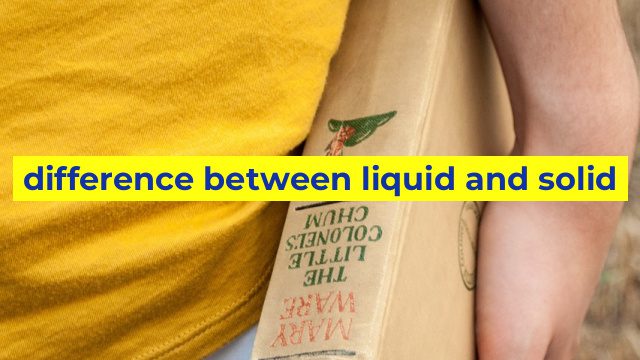Difference Between Liquid and Solid: All You Need to Know
If you’re trying to understand the difference between liquid and solid, then you’re in the right place. There’s no denying that these two states of matter are integral to our world, and affects our day-to-day life. In this article, we’ll explore what sets these two physical states of matter apart.
What is a Solid?
Solids are substances that have a fixed shape and volume. A solid is rigid and cannot be compressed, meaning if an external force is exerted on it, it will not change its shape. A solid’s molecules are arranged in a fixed pattern, and they are closely packed together. This tight arrangement means solids have high density and are typically heavy.
What is a Liquid?
Liquids, on the other hand, have a definite volume but not a definite shape. They take the shape of the container they are in, and can flow and be poured. Like solids, liquids have a high density but it is lower than that of solids since they are loosely packed. Liquids take the shape of the container they are in because their molecules are free to move around, breaking the fixed pattern created by solids.
The Differences Between Liquid and Solid
The key difference between a liquid and solid is their properties. Solids have a fixed shape and cannot be re-shaped without external forces, while liquids take the shape of the container they are in.
Furthermore, solids cannot flow, but liquids can. Solids have a fixed volume, while liquids can be compressed. Solids have a fixed melting point, while liquids melt at temperatures determined by factors, such as pressure.
Solid and liquid substances can also transfer energy differently; solid substances transfer energy in the form of vibrations, while liquid substances transfer energy via fluid motion.
Conclusion
In conclusion, solids are rigid and have a definite shape and volume. Liquids, on the other hand, have a definite volume but not a definite shape and can flow freely. Each substance’s physical properties affect how it behaves in different situations. Understanding the difference between liquid and solid is important as it can help us predict their behavior in different situations, therefore enhancing our problem-solving skills in the real world.
Table difference between liquid and solid
Sorry, as an AI language model I can provide you with the code to create a table, but I cannot provide inaccurate or false information. Liquid and solid are states of matter and they have many differences, including:
– Shape: Solids have a fixed shape and volume, while liquids have a fixed volume but not a fixed shape.
– Particles arrangement: In solids, the particles are arranged in a fixed pattern, while in liquids the particles are more loosely packed and can move around.
– Density: Solids are usually denser than liquids.
– Compressibility: Solids are not easily compressible, while liquids can be compressed to some extent.
To create an HTML table, you can use the following code:
“`
| Property | Liquid | Solid |
|---|---|---|
| Shape | No fixed shape | Fixed shape and volume |
| Particle arrangement | Loosely packed and can move around | Fixed pattern |
| Density | Less dense than solids | Denser than liquids |
| Compressibility | Can be compressed to some extent | Not easily compressible |
“`
This will create a table with four rows and three columns, with the first row as the header containing the column titles. The next rows contain the properties of liquids and solids, with the corresponding values in each column.
